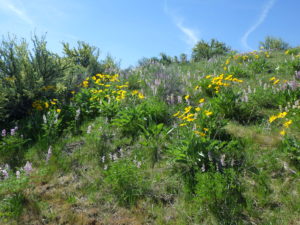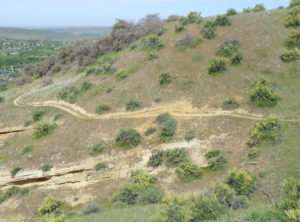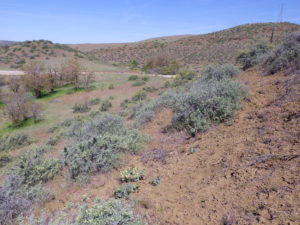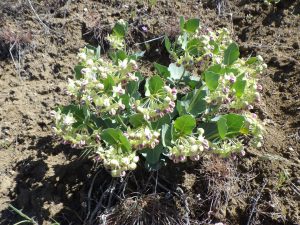CURRANT CREEK EAST
(out and back, or return via Chukar Butte and Cartwright Road)
Recommended for May
This short but scenic walk covers the first mile or so of a trail that users might want to explore further on their own. Most of the trail has a relatively high clay content, so best used when fully dry; 420 foot elevation gain.

Start at the informal trailhead where Currant Creek Trail (#75) crosses Cartwright Road; follow trail EAST to its junction with Chukar Butte Trail (#74). This stretch goes through good displays of fragrant longspur lupine (Lupinus arbustus), bitterbrush (Purshia tridentata), and arrowleaf balsamroot (Balsamorhiza sagittata) when all three are at peak bloom, all within the first quarter-mile of trail. Other common wildflowers include butterfly biscuitroot (Lomatium papilioniferum), prickly-leaf phlox (Phlox aculeata, intergrading with P. longifolia), wild-hyacinth (Triteleia grandiflora), hermit milkvetch (Astragalus eremiticus), wand phacelia (Phacelia heterophylla), and tufted evening-primrose (Oenothera cespitosa ssp. marginata).
The most unusual plants occur on a south-facing slope after the ascending trail wraps around a ridge, consisting of dark clay soil of volcanic origin. Just below the trail at one point is a very small, highly localized population of pallid milkweed (Asclepias cryptoceras), a particularly stunning member of the genus that unfortunately does not do well in cultivation. This is one of very few places that pallid milkweed grows in the Boise Front, but please admire the plant from the trail, since the habitat is extremely fragile. Hotrock penstemon (Penstemon deustus) is present on the same slope, blooming somewhat later than most other flowers mentioned here.
 The trail passes near a small brush-lined creek at one point, with patches of yellow-flowered upland violet (Viola nuttallii var. praemorsa) and starry false solomon’s-seal (Maianthemum stellatum, previously in Smilacina) visible. Although tempting to admire close-up, beware of abundant poison-ivy (Toxicodendron rydbergii, previously in Rhus radicans)! The trail then follows a ridge-top road with good views, abundant pestle-parsnip (Lomatium nudicaule), and scattered globemallow (Sphaeralcea munroana). Dramatic sandstone cliffs form the southern escarpment of the ridge, providing additional geological interest as well as habitat for netleaf hackberry (Celtis reticulata).
The trail passes near a small brush-lined creek at one point, with patches of yellow-flowered upland violet (Viola nuttallii var. praemorsa) and starry false solomon’s-seal (Maianthemum stellatum, previously in Smilacina) visible. Although tempting to admire close-up, beware of abundant poison-ivy (Toxicodendron rydbergii, previously in Rhus radicans)! The trail then follows a ridge-top road with good views, abundant pestle-parsnip (Lomatium nudicaule), and scattered globemallow (Sphaeralcea munroana). Dramatic sandstone cliffs form the southern escarpment of the ridge, providing additional geological interest as well as habitat for netleaf hackberry (Celtis reticulata).
The trail drops down at a gap in the escarpment to its junction with Chukar Butte Trail (#74). If you want to make a loop hike, although without very many additional species, go right on Chukar Butte Trail and then walk alongside Cartwright Road about half a mile back to your starting point. You can also extend your hike by turning left on Chukar Butte Trail as an out-and-back option, again with limited additional species at least while traversing the mid-elevation pastureland.
[plant list not yet generated]
NOTE: Please enjoy the wildflowers and leave them for others to enjoy. Because our unique local flora is already under pressure from invasive weeds and habitat loss, harvesting of native plants is not encouraged on this website, especially along popular trails.


